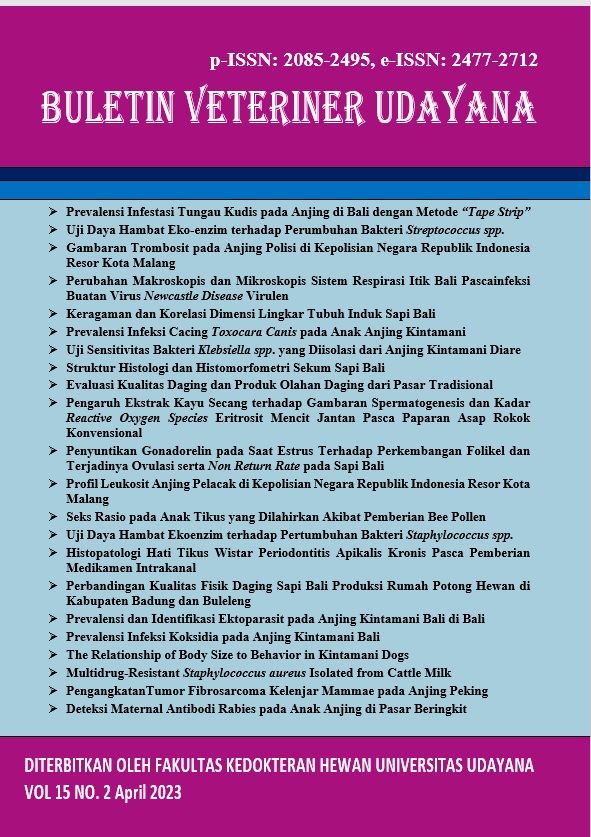DETECTION OF MATERNAL ANTIBODY AGAINST RABIES IN PUPPIES IN BERINGKIT TRADITIONAL MARKET
Abstract
In an effort to eradicate rabies, vaccination has been carried out for rabies carriers (HPR), such as dogs, cats and monkeys. Vaccination of dogs in the field has been carried out by the district/city Animal Husbandry Service once a year which is centered on each sub-village and even visits household from door to door. In order to provide a good protection, vaccination coverage is should above 70% of the HPR population at risk. Mother dogs who have antibodies will transfer them to their puppies through the placenta and milk when they give birth. Antibodies transferred from mother to child are called Maternal Antibodies (MA). To find out whether puppies have MA rabies, a study was conducted on puppies at the Beringkit Market, Badung Regency, using a descriptive observation method. The research aims to detect whether the puppies sold at the Beringkit market have maternal antibodies. ELISA test is conducted to measure the antibody from serum sample. A total of 30 serum lample were examined. From the results of the study using, 40% of 30 dog have had protective maternal antibodies (OD value >0.5IU) and 60% have not had protective maternal antibodies.
Downloads
References
Dibia IN, Sumiarto B, Susetya H, Putra AAG, Scott-Orr H, Mahardika GN. 2015. Phylogeography of the current rabies viruses in Indonesia. J. Vet. Sci. 16(4): 459–466.
Mahardika GNK, Dibia N, Budayanti NS, Susilawathi NM, Subrata K, Darwinata AE, … Sudewi AAR. 2014. Phylogenetic analysis and victim contact tracing of rabies virus from humans and dogs in Bali, Indonesia. Epidemiol. Infect. 142(6): 1146–1154.
Niewiesk S. 2014. Maternal antibodies: Clinical significance, mechanism of interference with immune responses, and possible vaccination strategies. Front. Immunol. 5(SEP): 1–15.
Salbahaga D, Supartika IKE, Berata IK. 2012. Distribusi lesi negri’s bodies dan peradangan pada otak anjing penderita rabies di Bali. Indon. Med. Vet. 1(3): 352–360.
Sari SRPW, Mahardika IGNK, Tenaya IWM. 2021. Deteksi antibodi terhadap rabies pada anjing lepasan berdasarkan topografi wilayah di Kabupaten Badung, Bali. J. Vet. 22(3): 398–405.
Suardana IBK, Widyastuti SK, Pradnyadana IBK, Agustina KK. 2023. Effect of age and presence of maternal antibodies on success of Avian Influenza and Newcastle Disease vaccinations in broiler. Int. J. Vet. Sci. 5(1): 44–47.
Utami NWA, Agustina KK, Atema KN, Bagus GN, Girardi J, Harfoot M, … Hiby E. 2019. Evaluation of community-based dog welfare and rabies project in Sanur, a sub-district of the Indonesian island province of Bali. Front. Vet. Sci. 6: 1–12.
Vandeputte J, Too HL, Ng FK, Chen C, Chai KK, Liao GA. 2001. Adsorption of colostral antibodies against classical swine fever, persistence of maternal antibodies, and effect on response to vaccination in baby pigs. Am. J. Vet. Res. 62(11): 1805–1811.
WHO. 2021. Rabies. Retrieved from Fact sheet website: https://www.who.int/news-room/fact-sheets/detail/rabies





